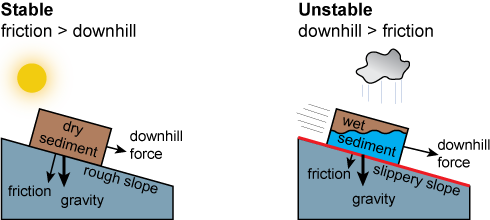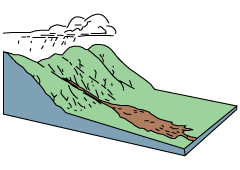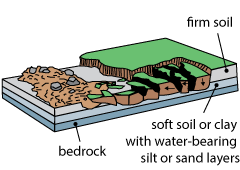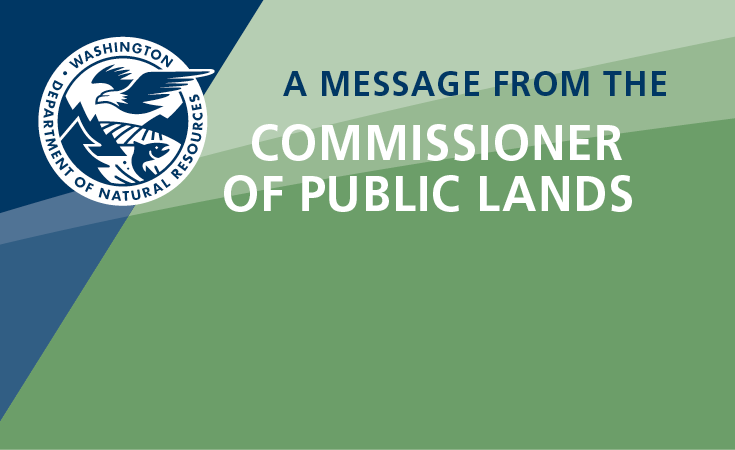
The 2009 Nile landslide blocked the Naches River and covered State Route 410.
Washington is one of the most landslide-prone states in the country, with hundreds to thousands of events each year. The direct cost of landslide damage includes the repair of roads and property and the loss of life. Indirect costs, such as loss of property value and tax revenue, and environmental effects, such as the degradation of water quality, can exceed direct costs. The Washington Department of Transportation routinely budgets $15 million a year for cleanup of landslides on highways. Nationally, landslides exceed $2 billion in loss each year and result in an estimated 25–50 deaths (1996 estimate).
FIND MAPPED LANDSLIDES
The Washington Geological Survey works to increase public and scientific understanding of landslide hazards in Washington State. Please visit our Geologic Information Portal and Geologic Hazard Maps page for the most up-to-date listing of all of our hazard maps.
|
|

|
Consider subscribing to our blog, Washington State Geology News, to receive notifications when new information is published. Also check out Ear to the Ground, published by the Department of Natural Resources.
The information on this webpage is also contained in two factsheets: Landslide Hazards in Washington State and What Are Landslides And How Do They Occur?
Landslide Inventory Mapping
Following the landslide inventory methods first produced by the Oregon Department of Geology and Mineral Industries, the Washington Geological Survey has developed their own landslide inventory protocol for Washington State. The Landslide Hazards Program at the WGS is producing landslide inventories for densely populated areas.
Landslide geologists use Lidar derivatives to map landslides. The landslides are delineated with polygon and line features as well as given 17 unique attributes, including a movement type, a movement azimuth, and a confidence rating (how certain the geologist is that the feature is a landslide). A percentage of the landslides are field-checked and all landslide polygons are reviewed by a licensed geologist. The data is assembled into a database and susceptibility maps are produced using the data. While landslide polygons indicate areas where landslides have already occurred, landslide susceptibility attempts to highlight areas that could experience a landslide in the future. The inventory is given to decision-makers in the state, which helps them make informed planning decisions.
Use the interactive map below to see where landslide mapping has been completed, is ongoing, or is planned.
Alluvial Fan Mapping
Check out our story map about the intersection between wildfires and alluvial fans in Klickitat County. This story map accompanies Report of Investigations 44 and the related mapping data on the Geologic Information Portal.

WHAT WE DO
The mission of the Washington Geological Survey is to collect, develop, use, distribute, and preserve geologic information to promote the safety, health, and welfare of the citizens, protect the environment, and support the economy of Washington.
Communicate landslide hazard to the public
The Washington Geological Survey works to increase public and scientific understanding of landslide hazards in Washington State. Please visit our Geologic Information Portal and Geologic Hazard Maps page for the most up-to-date listing of all of our hazard maps.
|
|

|
Consider subscribing to our blog, Washington State Geology News, to receive notifications when new information is published. Also check out Ear to the Ground, published by the Department of Natural Resources.
The information on this webpage is also contained in two factsheets: Landslide Hazards in Washington State and What Are Landslides And How Do They Occur?
LANDSLIDE HAZARDS IN WASHINGTON STATE
As our population expands into hilly and mountainous rural forests and agricultural lands, the need for mapping and understanding landslides and landslide hazards becomes increasingly urgent. Coupled with climatic change prediction for more frequent and intense storm events, mapping and understanding geologic hazards can greatly reduce impacts to infrastructure, loss of life, and property.
Landslides cause widespread damage but are often under-represented and understudied compared to other potential geologic hazards such as earthquakes, tsunamis, and volcanoes. Landslides are complex, often moving in numerous different ways, from small shallow slumps and rock topples to deep-seated landslides. Understanding how and why these landslides move help geologists develop mitigation techniques and determine future hazards for roads, houses, infrastructure, and human life.
The information on this webpage is also contained in two factsheets: Landslide Hazards in Washington State and What Are Landslides And How Do They Occur?
LANDSLIDE WARNING SIGNS AND TRIGGERS
- Warning signs of a landslide
- Common landslide triggers
-
Warning Signs of an Impending Landslide
Landslides are dangerous and unpredictable. Some landslides may provide clues that they are about to happen; others may happen suddenly without any warning signs.
- Cracks growing in the ground; downslope movement of rock, soil, or vegetation.
- Sudden changes in creek water levels, sometimes with increased sediment, especially during or right after large or protracted storm events.
- Sounds of cracking wood, knocking boulders, groaning of the ground, or other unusual sounds, especially if the sound increases.
If you notice these signs or observe a landslide in progress...
Leave the area immediately if it is safe to do so! Landslides are dangerous, unpredictable, and can occur rapidly. A landslide can easily destroy or bury a car or house. Report the problem immediately to your county Emergency Manager.
Warning Signs of a Potential Landslide
- A hillside that has increased spring and (or) seep activity, or newly saturated ground, especially if it was previously dry.
- New or developing cracks, mounds, or bulges in the ground.
- Sagging or taut utility lines; leaning telephone poles, deformed fences, or or tilting of trees on a hillside.
- Sticking windows or doors; new and (or) growing cracks in walls, ceilings, or foundations.
- Broken or leaking utilities, such as water, septic, or sewer lines.
- Separation of structures from their foundation; movement of soil away from foundations.
- Changes in water well levels or water wells that suddenly run dry.
- Movement of the ground.
What to do if you think a landslide may occur
Signs of a potential landslide should be reported to your county Emergency Manager so that the area can be properly evaluated.
REDUCE YOUR RISK

The Aldercrest–Banyon landslide complex was active for nearly a year and eventually destroyed 138 homes. Photo by Tim Walsh, WGS.
Most shallow landslides and flows occur during or up to several days after a heavy rainfall or rapid snowmelt event. Deep-seated landslides can occur at any time. Earthquakes can also initiate landslides, so be alert if you feel the ground shake and you are near a slope.
- Educate yourself about your landslide risk. Locations that experienced landslides in the past are more likely to have future landslides. The Washington Geologic Information Portal contains the most comprehensive listing of landslides available. However, because not all landslides are mapped, the absence of a landslide in the database does not indicate the absence of risk.
- Make a landslide emergency plan. Know what areas near your home or work are at risk. Know which areas are safe and how to reach them in an emergency.
- Consider evacuating prior to storm events which can cause sudden flooding and (or) landslides.
- Avoid living in locations that are hazardous. Areas above or below steep slopes, or in areas known to have frequent landslides, are more likely to experience landslides in the future.
- Consult a licensed engineering geologist or licensed geotechnical engineer if you would like a site-specific evaluation.
- Control runoff from buildings and roads so it flows away from steep slopes and into natural drainages or storm drains.
During dangerous weather
- Seek out advisories and warnings during and after intense rainfall events. Check the NOAA Weather Radio and your local TV stations.
- Don't assume that highways are safe—watch for collapsed pavement, mud, fallen rock, or other debris on the roadway.
- Listen for loud or unusual sounds. These can be indicators of an imminent landslide. If you think there is danger, evacuate immediately.
- Keep away from landslide-prone areas.
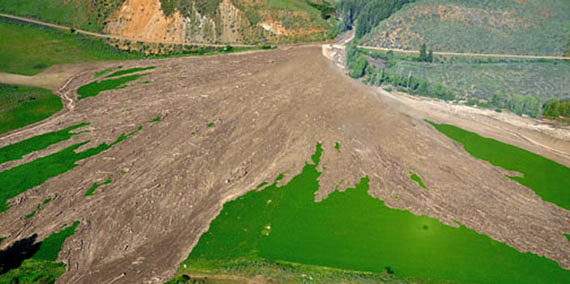
The 2011 Pearrygin Creek debris flow north of Twisp, Washington spread out when it emerged from a confining canyon. Photo by Jack Powell, WGS.
WHY DO LANDSLIDES HAPPEN?
A landslide generally refers to the downhill movement of rock, soil, or debris. The term landslide can also refer to the deposit that is created by a landslide event. The data on this website are meant to provide general information only; real landslides have many variables.
- Gravity
- Water
- Friction
TYPES OF LANDSLIDES
Landslides can occur as flows, slides, or falls and topples. A major difference between the types of landslides is their depth and the amount of water they contain. The images in this section are modified from the U.S. Geological Survey.
It is important to note that the type or size of landslide is largely irrelevant if you happen to be the one in harm's way. Under the appropriate circumstances, any landslide type can pose a serious hazard to life or property.
- Shallow and deep landslides
- Flows
- Slides
- Falls and topples
RECENTLY REPORTED LANDSLIDES
The interactive map below shows recently reported landslides compiled by the Washington Geological Survey based on reports from media sources and government agencies. The compilation is updated regularly throughout the year and includes reported landslides since 2015. Click on the image below to go to the map.

SOME HISTORIC LANDSLIDES IN WASHINGTON STATE

| Some historic landslides in Washington State | |
| Slide or area name | Date |
| (A) SR 530 (aka Oso or Hazel) | Mar. 2014 |
| (B) Nile | Oct. 2009 |
| (C) Aldercrest–Banyon | Feb–Oct. 1998 |
| (D) Mount St. Helens | May 1980 |
| (E) Lake Roosevelt | 1944–1953 |
| (F) Tacoma Narrows | Apr. 1949 |
| (G) Ribbon Cliffs | Dec. 1872 |
| (H) Bonneville | mid-1400s |
A more comprehensive list of significant landslides in Washington is available here
RESOURCES
City/County Emergency, Health, and Planning Departments
Washington Geological Survey
- Homeowners Guide to Landslides
- Fact Sheet: What are landslides?
- Fact Sheet: Landslide hazards
- Geologic Information Portal
- Washington State Forest Practices Board Manual Evaluating Unstable Slopes







